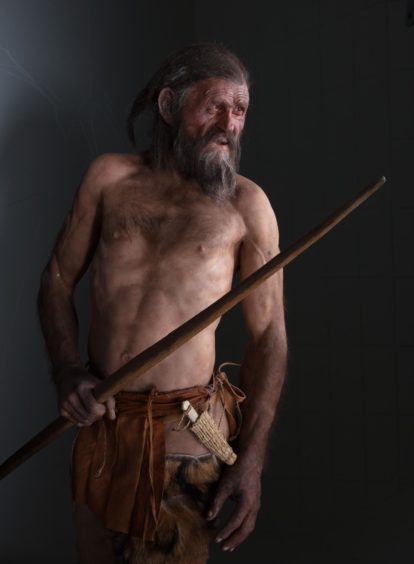It was one of the most remarkable discoveries in archaeological history; the perfectly-preserved body of a 5,300-year-old Neolithic man in the Alps in 1991.
Since Otzi was found almost 30 years ago, scientists have investigated myriad facets of his life and death and he and his bow and arrows, dagger, copper axe and other tools, attract thousands of tourists to a museum in Bolzano in Italy.
The emerging picture of Otzi’s life has been remarkable.
And now, clues to his last journey have been revealed through the identification of mosses and liverworts which were frozen with him, according to new Glasgow University research.
The study – published in PLOS ONE and in collaboration with the University of Innsbruck – has identified at least 75 species of brypophytes – mosses and liverworts – which were preserved with the Iceman.
It is believed they could hold important pointers to his last moments.
When he was originally discovered, his mummified body was frozen alongside his clothing and gear, as well as an abundance of plants and fungi.
Today, 23 bryophyte species live in the area, but inside the ice, researchers have identified thousands of preserved bryophyte fragments, representing at least 75 species.
Only 30% of them appear to have been local, with the rest having been transported to the spot by Otzi’s gut or clothing, or by large herbivores such as the Alpine Ibex whose droppings ended up frozen alongside the Iceman.
These have helped confirm the path he took to his final resting place and suggest that he travelled a long way before his death.
Scientists previously pinpointed a flint arrowhead which was lodged in the ancient man’s back and a deep wound in his right hand, supporting the theory that Otzi perished after a violent confrontation.
Emeritus Professor Jim Dickson, honorary senior research fellow at the university’s Institute of Biodiversity, Animal Health and Comparative Medicine, has been studying the ice mummy since 1994.

He said: “Most members of the public are unlikely to be knowledgeable about bryophytes (mosses and liverworts).
“However, no fewer than 75 species of these important investigative clues were found when he was removed from the ice.
“They were recovered as mostly small scraps from the ice around him, from his clothes and gear, and even from his alimentary tract.
“Those findings prompted the questions: Where did the fragments come from? How precisely did they get there? How do they help our understanding of the Iceman?”
“Some of the mosses are important in investigating the precise route of his very last journey.
“The crucial one is called Flat Neckera, a woodland species, which was found both as a large mass adhering to his clothes and as microscopic pieces in his gut.
“That discovery and other mosses of similar ecology from low to moderate altitude are as near proof as it is possible to get that the Iceman climbed from south to north up Schnalstal rather than ascending other adjacent valleys.”

